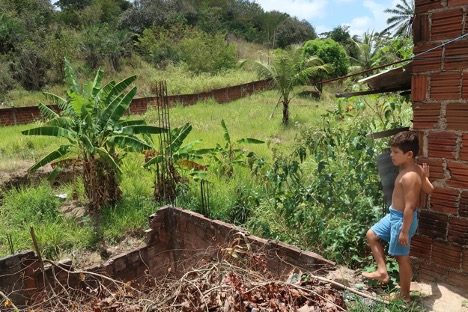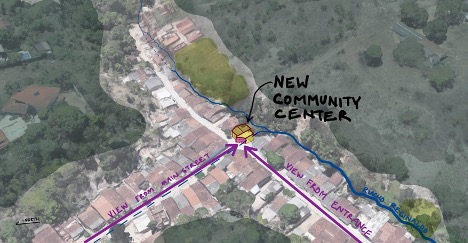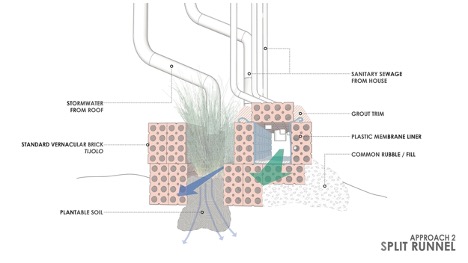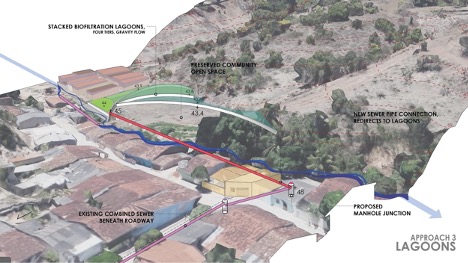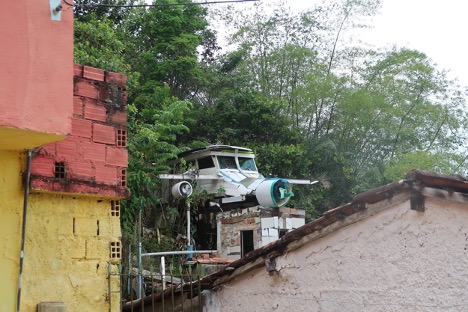
Community Vitality in a Valley of Environmental Justice: Urban Landscape Architecture in a Brazilian Grota
BY SAM VALENTINE
June 11, 2020
This article was originally published on the website of Topos Magazine. You can find it here.
Maybe it overshot the runway. As I walked the narrow cobblestone street of this low-lying village in northeastern Brazil, the glint of a glass windshield caught my eye, revealing a decrepit tangle of cockpit, wings, and propellers perched on an overgrown bluff above the community’s rooftops.
Comunidade Poço Azul is a pocket community of about 500 residents within the metropolis of Maceió, Brazil, which exceeds a million. Back before the COVID-19 pandemic, during my first semester in the Master in Landscape Architecture program at Harvard Graduate School of Design, I squeezed in attending a presentation that was given by a visiting lecturer. Ana Rosa Chagas Cavalcanti, an architect and urban planner, presented her studies of self-construction and communal space and shared the social observations and architectural interventions that she undertook in several communities in her hometown of Maceió.
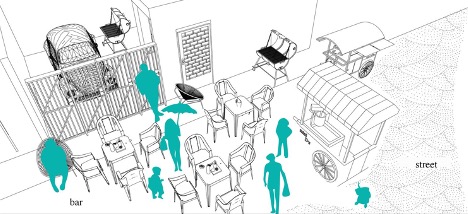
Fast forward a year and I find myself temporarily living in none other than the city of Maceió, drawn here not by its renowned beaches or year-round warmth but by the challenges of scarcity and sanitation that define life for so many.[1] A large portion of the city’s residents live in self-built communities that are neither authorized nor accommodated for by the municipal government. Along with a growing portion of human beings across the so-called “Global South,” these residents must battle for access to education, healthcare, sanitation infrastructure, and even legally recognized addresses.
A Riacho Runs Through It
Upon my first visit to downtown Maceió, I was astonished to see the Riacho Reginaldo (also referred to as Riacho Salgadinho). Despite the alleés and strokes of beautification flanking it, the Riacho — a Portuguese term meaning “large stream” or “small river” — is visibly choked with floating trash and raw sewage as it flows into the Atlantic Ocean. To put this politely, if you are within a block of the Riacho, eyes shut, you can see the waste in graphic detail. I decided to orient my final studio course around the topic of the Riacho and the question of what our profession of landscape architecture might be able to offer (if anything) towards improving the condition of this pungent, disease-bearing river of urban blight.

My studio research threaded me through centuries of indigenous heritage, industrial development, catastrophic flooding, and both environmental and physical violence. Once offering a source for fresh drinking water and hydraulic power, as well as navigable land routes to the city’s plateaued highlands, the Riacho served as the organizational backbone for the development of Maceió from the seventeenth century to the present. After understanding the lineage of failed engineering projects and political scandals, and finally realizing that the Riacho is polluted by hundreds of thousands of individual point sources along its fifteen-kilometer (nine-mile) run, I questioned my project selection altogether. In the self-constructed communities that dominate the river valley, each toilet, sink, and floor drain are plumbed directly into the Riacho.
Our studio instructor, Sierra Bainbridge of MASS Design Group, built the course around the concept of “community partnerships,” and in my quest to find a local organization with interest and/or capacity to create change along the Riacho, I reached out to Cavalcanti. She connected me to Projeto Azul, based in a valley far upstream, and warned me that though the community was near the headwaters of the entire Riacho, that natural wellspring had been destroyed by anthropogenic change decades ago. Communicating with Projeto Azul through the all-to-familiar combination of Instagram, Zoom, and WhatsApp, we set up my first in-person visit to their neighborhood: Comunidade Poço Azul.
Welcome to the Neighborhood
There are so many words used for the urban conditions seen in the community of Poço Azul, it is hard to know what to say. The denigrating term “slum” is still used by the United Nations. The milder label “informal settlement” is now withering in the face of criticism. Even the word “favela,” which was popularized through cinematic imagery of Brazil’s urban mountainsides, does not apply here. Locals refer to these valley-nestled communities as grotas. As I am learning, Brazilians have a varied palette of terms — aglomerado subnormal, palafita, periferia, invasão — for their communities of scarcity, names that vary both in their topo-geographic descriptions and their vicious classism.
With Projeto Azul founders Artur, Duda, Evandro, and Fernanda leading me through their community, its history unfolded. By residents of middle- and upper-class Brazilian neighborhoods, grotas are considered to be temporary settlements for newly arrived migrants still seeking stable work and – eventually — formal housing. Yet the team facilitated several sidewalk conversations that allowed me to hear from residents who had been dwelling in the valley for twenty, thirty, and even forty years.
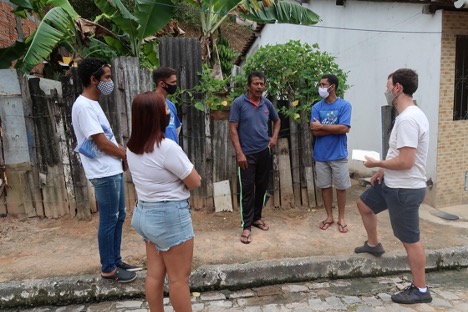
Over the decades, the handful of isolated homes had grown to a community of hundreds. Today Poço Azul’s homes tidily front upon two streets, which trace ancient streambeds to join in a T-intersection between three surrounding plateaus. Fleeting views reveal that those who live on the plateaus above have a very different lifestyle from those in the gully: the plateau residents live thirty vertical meters (one-hundred feet) above in the affluent neighborhoods of Antares, Aldebaran, and Jardim Petrópolis. They enjoy gated streets, freestanding homes with spacious green lawns, and a wealth of in-ground backyard swimming pools.
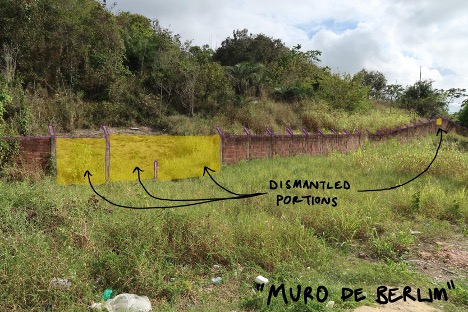
Walking for hours with the team let me understand their organizational goals as well. The twenty- and thirty-somethings spent their childhood in Poço Azul, and after finding education outside the community, they have returned with goals to establish education, health, and recreation programs for the next generations. They also led me to important clues about the community’s material culture. We came upon several homes in various stages of construction by “Zé Maconha,” the community’s unorthodox informal contractor. We also came up against the “Muro de Berlim,” an unfriendly brick wall with reinforced concrete posts, named satirically by the residents for its Cold War cousin. The members explained that this wall was erected in recent years by an adjacent landholder to prevent the continued expansion of the community onto his parcels. Twist ending: the wall showed evidence of partial disassembly, with brick and concrete units repurposed to enable further self-construction of dwellings.
The famed source of Riacho Reginaldo is a poço, or natural well, that was buried by sedimentation likely due to deforested hillsides. Curiously, a small creek still flows over the deathbed of the poço for which this community was named. Following this creek to the upland edge of the community revealed something disheartening. Reaching a point in the creek where no community homes remained upstream, it was still thickly polluted. Artur pushed into a recently disturbed hillside forest to find an outlet pipe he had never seen before roaring with fetid sludge. The epitome of environmental injustice, this polluted pipe clearly leads from the upper elevation (and upper-class) neighborhood of Aldebaran, and it was surging with untreated sewage even when rain had not fallen in days.
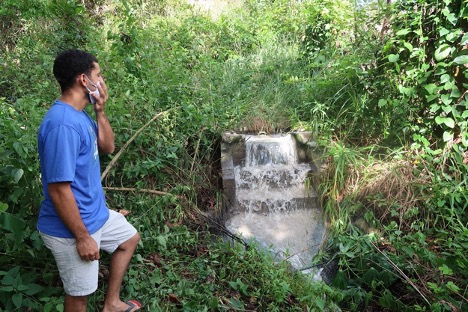
What Landscape Architecture Can Offer
The hydrologic and material findings from my fieldwork quickly framed my studio project. Rather than absurdly trying to remedy the entire Riacho, I narrowed my focus to one headwater community. Across several desk (Zoom) reviews, guest critics Tim Duggan of Phronesis and Chris Kroner from MASS encouraged me to maintain operations on dual scales: to think of a replicable test case for the entire Riacho but also to focus on a feasible project meaningfully tailored to the specific needs of Projeto Azul.
I began to envision a system of public-realm, communal landscape spaces that would graft upon a skeleton of new stormwater infrastructure. I developed three approaches, independently viable but complementary, to improve the lives of residents and quality of water as it leaves the community.
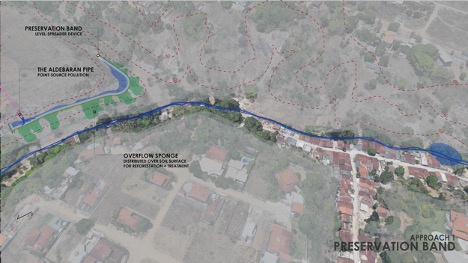
The first approach, what I’m calling a “Preservation Band,” is a rudimentary level-spreader, borrowed from civil engineering to disperse the volume of filthy water from the Aldebaran pipe over a large uninhabited landscape surface. The structure may only need to be 150 meters (500 feet) in length, but a clear run exists that would allow the Band to be elongated along the same datum if the Aldebaran outlet flow increases. The Preservation Band, essentially a low retaining wall, has the added potential to delimit community expansion, and the downslope landscape will benefit from increased soil moisture, encouraging revegetation of the slope.
Secondly, an easily constructed “Split Runnel” will allow retrofitting to separate each dwelling’s roof runoff from its sanitary sewer outflows. Built from tijolos, the ubiquitous, lightweight terracotta bricks that define both informal and formal developments of Brazil, the Runnel can be constructed in pieces that can be connected and improved over time. The value of the Split Runnel lies in its flexible constructability and legibility: relatively clean stormwater is directed into an open, grassy trench that leads to the creekbed, while the enclosed and membrane-lined sanitary trench leads to a sump or biofiltration lagoon.
The Biofiltration Lagoons are the third mitigation approach of my studio project. By intercepting the outflow of the combined sewer currently running from beneath the street directly into the creek, a new pipe can deliver this untreated sewage to a series of new tiered Lagoons. Careful grading maximizes storage volumes while preserving flat open space for community gatherings. The entire system is gravity-run, with no pumps required to keep it operational.
The open space can be used for passive recreation, but through my studio work I test-fit several organized events. In the case of an arts festival, for example, the Lagoon wall doubles as perimeter seating and the lawn accommodates picnics, small group games, and an arts and crafts market.
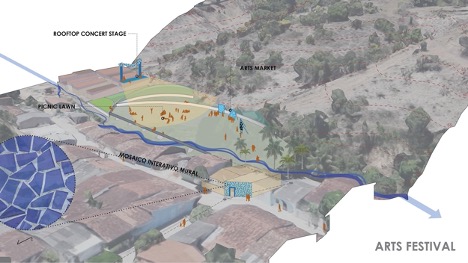
To be sure, many of these designs seem lofty, considering Projeto Azul is having challenges in securing smaller, fundamental funding for tables and chairs. In the design workshop held on our second meeting I brought more than just stormwater concepts, also preparing collaborative exercises to help them advance their organizational goals and find consensus on types of interior and exterior community spaces they desire. One of the direct benefits I have been able to provide so far is a set of floor plan schemes that spatialize these desires and make architectural changes — study rooms, a library wall, and a teaching kitchen — real and quantifiable.
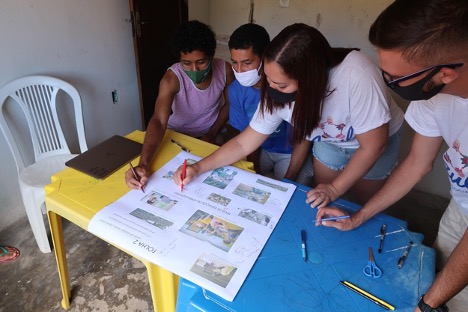
Projeto Azul, like the comunidade that it is working to strengthen, has numerous gaps between what it wants to accomplish and where it currently stands. But I am learning that Poço Azul and communities around the globe like it are best defined by their assets not their inadequacies. The community may be called “grota” in Portuguese, but in English the best descriptor that comes to mind is “village.” Children play in the streets, chaperoned by neighbors. Residents do not merely know one another’s names but also the names of their neighbors’ cousins. Despite the stigma of crime in self-built communities, one resident bragged to me that nobody bothers to lock their doors at night.
Back to the beginning, the precarious aircraft. Towards the end of our first walk, Evandro saw me photographing the plane and asked if I wanted to go see it. Taking me to the back patio of what turned out to be his family home, I gazed up a series of stairs, ladders, and ledges that mitigated the bluff. Evandro and his son led me up the plane, which up close revealed itself to be an architectural folly made entirely of building scraps.
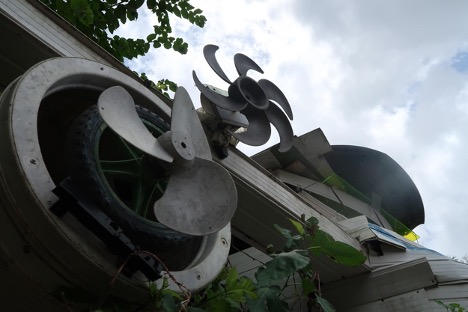
Inspired by the planes that buzz over the neighborhood from a runway on one of the overlooking plateaus, Evandro explained that the back of the cockpit harbors the family’s chickens, the sheltered space beneath is his father’s homemade ateliê, and the cockpit is where his father hangs out. The cockpit has seats, an assemblage console, and a working radio and headset, but the most memorable element for me was the view: a peaceful elevated vista over the rooftops of Comunidade Poço Azul.
(All photos by the author except where otherwise noted.)
[1] If this warrants further explanation: my girlfriend is coincidentally from Maceió. As we are both working remotely during the pandemic, we decided to sequester in her hometown until the situation improves. Being here affords me some access to my MLA thesis site for spatial research.
